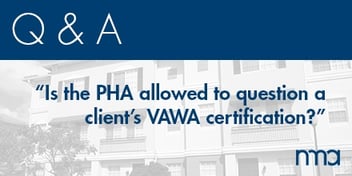Q&A: Occupancy of accessible units
 QUESTION My agency will have a vacancy soon in a unit that is fully wheelchair accessible. We have a request for an accessible unit from a resident who lives in another development. Her current unit has a ramp but she says the kitchen and bathroom are too small to turn around in her wheelchair.
QUESTION My agency will have a vacancy soon in a unit that is fully wheelchair accessible. We have a request for an accessible unit from a resident who lives in another development. Her current unit has a ramp but she says the kitchen and bathroom are too small to turn around in her wheelchair.
We also have an applicant on the waiting list who has requested an accessible unit. He currently lives in a shelter. Can we offer the unit to the applicant instead of the resident? The applicant seems to have a greater need and we’d like to avoid the costs involved in a transfer.
ANSWER No, the PHA may not offer the accessible unit to an applicant before offering it to a resident. The controlling regulation is at 24 Code of Federal Regulations 8.27. Here’s an excerpt from Notice PIH 2010-26, which contains the current HUD guidance on occupancy of accessible units:
When an accessible unit becomes vacant, the PHA shall:
-
First, offer the unit to a current occupant with disabilities in the same development that requires the accessibility features of the vacant accessible unit and occupying a unit not having those accessibility features. The PHA must pay moving expenses to transfer a resident with a disability to an accessible unit as an accommodation for the resident’s disability.
-
Second, if there is no current resident in the same development who requires the accessibility features of the vacant, accessible unit, the PHA will offer the unit to a current resident with disabilities residing in another development that requires the accessibility features of the vacant, accessible unit and occupying a unit not having those accessibility features.
-
Third, if there is no current resident who requires the accessibility features of the vacant, accessible unit, then the PHA will offer the vacant, accessible unit to an eligible, qualified applicant with disabilities on the PHA’s waiting list who can benefit from the accessible features of the available, accessible unit.
-
Fourth, if there is not an eligible qualified resident or applicant with disabilities on the waiting list who wishes to reside in the available, accessible unit, then the PHA should offer the available accessible unit to an applicant on the waiting list who does not need the accessible features of the unit. However, the PHA may require the applicant to execute a lease that requires the resident to relocate, at the PHA’s expense, to a non-accessible unit within thirty (30) days of notice by the PHA that there is an eligible applicant or existing resident with disabilities who requires the accessibility features of the unit.
Note that Notice PIH 2010-26 states that the PHA must pay moving expenses for a resident transferring to an accessible unit, and also for moving a resident to a non-accessible unit when necessary. HUD has discussed the costs involved in such a transfer in Chapter 11 of the Public Housing Occupancy Guidebook:
The reasonable cost of transfers includes not just the cost of packing, moving, and unloading, but also the cost of disconnecting and reconnecting any existing resident-paid services such as telephone and cable television.
Are you a PIH Alert subscriber? Every Friday, the PIH Alert includes one frequently asked question (FAQ) submitted by our readers. Sign up today for a free 30-day trial subscription! Email sales@nanmckay.com to get started. To submit your question, email Annie Stevenson at annie@nanmckay.com with the subject line "FAQ Friday."



